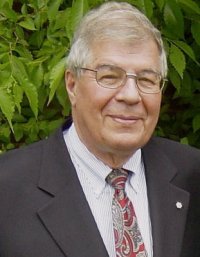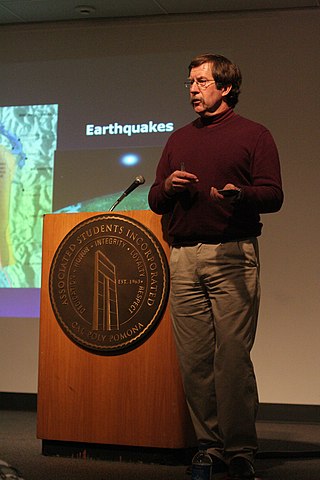The Logan Medal is the highest award of the Geological Association of Canada. Named after Sir William Edmond Logan, noted 19th-century Canadian geologist. It is presented annually to an individual for sustained distinguished achievement in Canadian earth science.
The J. Willis Ambrose Medal is an award presented by the Geological Association of Canada, and is named after the association's first President, J. Willis Ambrose. It is awarded annually, unless no suitable candidate is identified, "to an individual for sustained dedicated service to the Canadian earth science community."
Ronald M. Clowes, CM is a professor specializing in seismic and other geophysical studies of the Earth's lithosphere. For his work he has been appointed a member of the Order of Canada.
James (Jim) W.H. Monger is an emeritus scientist of the Geological Survey of Canada and a world leader in the application of plate tectonics to the study of mountain chain formation.

Ernest Richard Ward Neale, was a Canadian geologist. His scientific research contributed to the understanding of the large-scale structure of the northern Appalachian mountains of Atlantic Canada. Neale used his enthusiasm for geology to inform students and the general public about discoveries in his field through television, radio, pamphlets, booklets, news magazines, and the popular press.
Women in geology concerns the history and contributions of women to the field of geology. There has been a long history of women in the field, but they have tended to be under-represented. In the era before the eighteenth century, science and geological science had not been as formalized as they would become later. Hence early geologists tended to be informal observers and collectors, whether they were male or female. Notable examples of this period include Hildegard of Bingen who wrote works concerning stones and Barbara Uthmann who supervised her husband's mining operations after his death. Mrs. Uthmann was also a relative of Georg Agricola. In addition to these names varied aristocratic women had scientific collections of rocks or minerals.

Edward A. "Ted" Irving, was a geologist and scientist with the Geological Survey of Canada. His studies of paleomagnetism provided the first physical evidence of the theory of continental drift. His efforts contributed to our understanding of how mountain ranges, climate, and life have changed over the past millions of years.
Robert John Wilson Douglas (1920–1979) was a Canadian geologist who made contributions in the fields of structure stratigraphy, sedimentation, and petroleum geology.

Raymond Alexander Price, is a Canadian geologist. He has used his research on the structure and tectonics of North America’s lithosphere to produce extensive geological maps. He has also provided guidance for nuclear fuel waste disposal and reports on the human contribution to Global warming.
John Oliver Wheeler was a Canadian geologist, who spent most of his career as a research scientist with the Geological Survey of Canada.
Lithoprobe was a Canadian national geoscience research project funded by the Natural Sciences and Engineering Research Council from 1984 to 2005, and one of the largest geoscientific research programs in Canadian history. The project aimed to research and map the lithosphere structure and composition, and its findings were used by scientists as well as petroleum and mining companies. By the end of the project, Lithoprobe had employed more than 1,000 scientists.
Richard Lee Armstrong was an American/Canadian scientist who was an expert in the fields of radiogenic isotope geochemistry and geochronology, geochemical evolution of the earth, geology of the American Cordillera, and large-magnitude crustal extension. He published over 170 scientific papers.
Eric Walter Mountjoy was a Canadian geologist, who spent much of his career as a professor at McGill University. He was a foremost expert on sedimentology, Devonian reefs, carbonate diagenesis, porosity development and the structure of the Rocky Mountains. His research has provided useful applications to the petroleum industry.
Gabrielse Cone is a remarkably fresh, clearly postglacial monogenetic cinder cone, located in the Tuya Volcanic Field in British Columbia, Canada. It is about 400 m (1,312 ft) in diameter and has a central crater about 30 m (98 ft) deep. It is Holocene in age and to its northeast appears to be breached with the remnants of a lava flow. The cone is near the headwaters of Iverson Creek.

John Joseph Clague PhD FRSC OC is a Canadian authority in Quaternary and environmental earth sciences. He is a professor of earth sciences at Simon Fraser University and an emeritus scientist of the Geological Survey of Canada.
Edward Howel Francis, BSc, DSc, FRSE, FGS was a British geologist and Emeritus Professor of Earth Sciences at the University of Leeds. He was President of the Geological Society of London from 1980 to 1982.
Jack Gordon Souther was an American-born Canadian geologist, volcanologist, professor and engineer. He contributed significantly to the early understanding of recent volcanic activity in the Canadian Cordillera. Many of his publications continue to be regarded as classics in their field, even now several decades after they were written.
The Man on the Hill (MOTH) locality of northwestern Canada has fossils that are very well preserved and have had a profound impact on the understanding of vertebrate evolution. The geology of the MOTH locality consists of fine, alternating laminae of light grey argillaceous limestone, or calcareous shale, and dark grey silt to sand-rich calcareous shale, as observed in thin section, and the characterization of the lithology for the vertebrate-bearing strata as an interlaminated argillaceous limestone and calcareous shale. The abundance of cryptic trace fossils and the presence of pyrite suggest that the intra-shelf topographic sag at MOTH had restricted circulation and was generally hypoxic.
Ernest Frederick "Fred" Roots was a Canadian geologist, polar explorer, educator and public servant. After graduating with undergraduate and master's degrees in geology from the University of British Columbia and a doctorate from Princeton University, Roots joined the Scott Polar Research Institute and was appointed Chief Geologist for the 1949 to 1952 Norwegian–British–Swedish Antarctic Expedition. During the expedition, in addition to ground-breaking geological and glaciological research studies, he made a 189-day, unsupported dog sled journey across the continent; a record that still stood at the time of his death over six decades later. On his return to Canada he joined the Geological Survey of Canada with whom he served as a field geologist until 1958, when he left to help found the Polar Continental Shelf Program. After 14 years with PCSP, Roots left to act as science advisor to the newly created federal Department of the Environment, where he remained on staff until 1989. After retirement, Roots remained an active participant in polar research, and also became a key mentor within the Students on Ice educational program. He continued to participate in expeditions for Students on Ice well into his tenth decade, his last being to Greenland only two months before his death.
Charlotte E. Keen is a Canadian geologist and professor emeritus at the Geological Survey of Canada. Her work focuses on the structure of the earth's crust and the upper mantle using geophysical imaging and magnetic measurements. She was the first woman to go on a Canadian Survey Ship.



